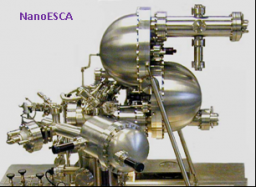
The laboratories of SPCSI are equipped with several apparatus for the study and analysis of surfaces under ultrahigh vacuum (UHV) that constitute a coherent platform for the characterization of surfaces up to the atomic scale:
3 STM et 1 STM-AFM OMICRON, all under UHV:
- The first room temperature STM, with a tripod tip holder, can routinely get the highest atomic resolution. Having a panoramic view of the tip-surface area, it is equipped with an efficient optical collector of photons emitted by the tunnel junction, for nanophotonic studies.
- The second STM allows temperature studies (100 - 600 K). Equipped with a piezo-electric scanner tube (tip holder), it allows the exploration of large surface areas (several µm2).
- The third is a mixed STM-AFM equipment. With a tuning fork cantilever and very recent electronics, it allows AFM and STM simultaneous operation (measuring force variation during a scan at constant current or conductivity measurement or tunnelling spectroscopy in a scanning at constant gradient strength). See the different AFM modes of operation.
- The fourth variable temperature STM-UHV apparatus is mainly devoted for laboratory experiments on "clean" solid surfaces like semiconductor, SiC, Graphene ...
A PEEM-LEEM (Low Energy Electron Microscopy - Photo-Emission Electron Microscopy) ELMITEC complete the UHV-STM set of apparatus. This device (2 ex. In France), allows by its electron optics (similar to that of a transmission electron microscope) to obtain images of surfaces at the scale of 10 nm. For this a high energy (20 keV) electron beam is slow down to interact with the surface at very low energy, then re-accelerated to form an spatial image through the electron optics (LEEM). Similarly, electrons emitted by photoemission allows giving an image of the surface (PEEM). This device is characterized by its excellent spatial resolution.
A X-ray Photo-Diffraction UHV apparatus (XPD) completes the platform. The technique gives access to the local structural and chemical order.
In collaboration with teams from the CEA-LETI (Grenoble), the SPCSI has regular access to a FOCUS-PEEM OMICRON 1st generation dedicated to the chemical analysis of surfaces, especially during measurement campaigns around European synchrotrons (tunability and high beam intensity).
The SPCSI drives the project to complete itys platform for UHV surface characterization by a "MesoXope" apparatus (PEEM type), whose performance will be optimized to achieve the ultimate sensitivity and spatial resolution for chemical imaging.
Access to all of this set of UHV apparatus for surface characterization is open to all internal within CEA and external collaborations. The maintenance of this park being relatively expensive, a cost sharing of maintenance is usually sought through the submission of projects to funding agencies for research (ANR RTRA, etc. ...).













